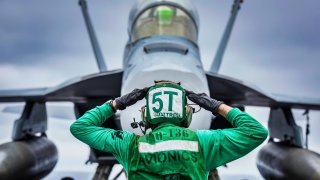How China Got Its Hands on a Western Aircraft Carrier and Dissected It for Secrets
China’s interest in becoming an aircraft carrier power dates back longer than 2012 and it did not involve derelict Russian flat tops. Instead, it was based on an old Royal Australian Navy light carrier that was built at the end of the Second World War and sold to China as scrap in the 1980s.
Summary: The underestimated rise of China's geopolitical and military capabilities, particularly in naval power, underscores a strategic evolution deeply rooted in the nation's history since Mao Zedong's era. Initially leveraging imitation as a strategic tool, China's acquisition and study of foreign military technologies—exemplified by the decommissioned HMAS Melbourne and the Russian carrier Liaoning—have laid the groundwork for its ambitious naval expansion. This meticulous approach enabled China to leapfrog technological gaps, transitioning from replication to innovation. Today, China's commitment to developing a formidable aircraft carrier fleet, including plans for a nuclear-powered carrier, signals a clear intent to challenge U.S. naval supremacy. The persistent underestimation of China's strategic patience and capability development by Western elites not only overlooks the historical continuum of Chinese ambitions but also misjudges the current trajectory towards achieving global maritime dominance. China's naval strategy, infused with advanced A2/AD systems, aims to secure regional superiority and challenge the U.S. at sea, reflecting a grand strategy envisioned by Mao and meticulously executed by subsequent leaders towards displacing the United States as the global hegemon.
China's Aircraft Carrier Dreams
The Chinese have consistently been underestimated by US national security officials, along with the national security officials of most Western states. Having been lulled into a false sense of security by the temporary alliance that existed between the People’s Republic of China and the West during the close decade or so of the Cold War (and blinded by the easy money that was flowing between the West and China), Western elites failed to comprehend the threat they faced from Beijing.
The Chinese Communist Party (CCP), commanded by Mao Zedong, was founded in bloody civil war with the nationalists, as led by Chiang Kai-Shek. Having defeated the Chinese Nationalists in 1949, Mao proudly called for his followers to, “Catch up to Great Britain and overcome the Americans!”
The Chinese threat which, in the last decade, has become unmistakable even to those Western elites who had been blinkered by China’s smooth talking from the 1970s-2000s, did not materialize a decade ago. It was a story long in the making—going back to the earliest days when Mao Zedong led his rag-tag communist insurgency against the Western-backed Nationalists.
In the CCP’s case, they were always playing catch-up with other powers, whether it be Great Britain, the United States, or the Soviet Union in the Cold War. They got a bad rap for being imitative rather than innovative. Yet, that imitation was strategic rather than a sign of incompetence. Why reinvent the wheel when one can simply replicate it, use it to catch up with the West, and then outpace the West?
At least, that’s what the CCP has intended for decades.
China’s Naval Buildup and Aircraft Carrier Focus
This is evident in China’s naval buildup.
Specifically, their attempts to create a viable aircraft carrier force (despite living in the age of anti-access/area denial warfare where carriers are increasingly obsolete). Most people know that China’s first real aircraft carrier was not indigenously produced. It was purchased from Russia and became China’s first carrier.
The Liaoning was actually just a glorified training vessel that was meant to give Chinese naval personnel the experience they needed to operate in real carrier environments. China then replicated the Liaoning in their next two carriers. Beijing’s fourth carrier will be of their own design—and it will be nuclear powered.
But China’s interest in becoming an aircraft carrier power dates back longer than 2012 and it did not involve derelict Russian flat tops. Instead, it was based on an old Royal Australian Navy light carrier that was built at the end of the Second World War and sold to China as scrap in the 1980s.
This warship, the HMAS Melbourne, had been gutted of its advanced systems. Nevertheless, the Chinese, who had assured Australia’s leaders they were going to break the warship down for scrap, did not dismantle the warship until almost 20 years after it was purchased. Instead, China dissected the outdated carrier to learn Western engineering preferences for their carriers.
The HMAS Melbourne’s Role in China’s Ambitions
Specifically, Chinese shipbuilders became fascinated by the HMAS Melbourne’s launch systems. The Melbourne operated a steam-driven catapult system for launching aircraft from its flight deck. When the Royal Australian Navy sold the vessel to Beijing for scrap, they had dismantled that system, as the catapult system is considered by most carrier-operating nations to be a national security secret.
Nevertheless, the Chinese spent nearly 20 years studying the gutted warship’s skeleton, learning the secrets of its catapult system. Even without a functional model to replicate, Chinese engineers were able to reverse-engineer a system.
Even before their curiosity in the steam-powered catapult system was piqued, Chinese naval planners had dismantled the ship’s flight deck and brought it on land in the 1990s. Once on land, they reassembled the Melbourne’s flight deck and practiced landing warplanes on the carrier’s flight deck. This was years before the Liaoning ever went into service.
What this shows is that China’s seemingly insatiable geopolitical ambitions did not begin in the 2010s, as so many observers seem to believe. It was not something that Xi Jinping brought with him into the office of China’s president. Instead, the grand ambition for China to dominate the world—displacing the United States as the sole hegemon—was a fantasy concocted by Mao himself and nursed throughout the generations in China, being handed down from one CCP leader to the next.
Each modern leader of China had a different methodology for working toward that end goal. But all were moving their country toward developing the capabilities for accomplishing the herculean task.
From Limitation to Innovation on Aircraft Carriers
China’s carrier program, while initially imitative, is already developing into an innovative capability. Western leaders underestimate China at their own peril. Just because China emulates and imitates to cut down on research and development time does not mean that China is not innovative. It just means they save their innovations for when they catch up to their competitors. Of course, the Americans can rest easy: the Chinese carrier fleet is not yet as sophisticated as the US Navy’s.
But they are catching up.
With each new unit the PLAN produces, some new advancement is made. What’s more, the fact that any conflict with the West will be fought much closer to Chinese shores means that the PLAN has home court advantage. The Chinese military has laced key regions with a powerful web of A2/AD systems designed to negate the power projection capabilities that US Navy carriers provide.
Once an A2/AD bubble is created over a contested region—such as the Taiwan Strait or South China Sea—it is assumed that China’s carriers will operate with a degree of impunity, allowing for China’s PLAN to assert sea superiority over their local rivals while the Americans hang back for fear of losing their expensive aircraft carriers to China’s A2/AD network.
This is not the behavior of a great power winging it. These are the moves by a great power that has been planning a bold strategy of displacement for decades. Now, that strategy is coming into maturation.
About the Author
Brandon J. Weichert, a National Interest national security analyst, is a former Congressional staffer and geopolitical analyst who is a contributor at The Washington Times, the Asia Times, and The-Pipeline. He is the author of Winning Space: How America Remains a Superpower, Biohacked: China’s Race to Control Life, and The Shadow War: Iran’s Quest for Supremacy. His next book, A Disaster of Our Own Making: How the West Lost Ukraine, is due October 22 from Encounter Books. Weichert can be followed via Twitter @WeTheBrandon.


